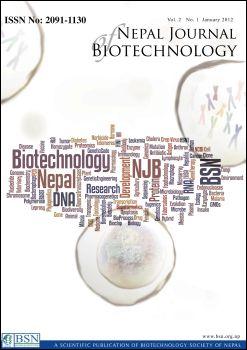Cloning, Expression, Purification, and Characterization of<i> Clostridium botulinum</i> Neurotoxin Serotype F Domains
DOI:
https://doi.org/10.3126/njb.v2i1.5634Keywords:
Clostridium botulunium, Botulinum Neurotoxin Type F (BoNT/F) domains, cloning, recombinant protein expression, immunoreactivityAbstract
The use of recombinant BoNT domains has been proposed as a means to develop strategies to treat and prevent botulism. Here, details on the molecular cloning, protein expression, purification, and immunoreactivity of BoNT/F domains from Clostridium botulinum are presented. Initially, full-length synthetic genes encoding recombinant BoNT/F domains (catalytic, translocation, and receptor binding) were designed and cloned into Escherichia coli for expression. Recombinant proteins were then purified through GST affinity chromatography preceding elution of GST-free recombinant domains by thrombin protease. Soluble recombinant proteins encoding catalytic light chain and translocation N-terminal heavy chain were subsequently used to perform in vivo immunization. Polyclonal mouse antibodies specific to these domains were raised, confirmed by Western blot analysis and elevated immunoreactivity was identified through indirect ELISA. In conclusion, availability of the recombinant protein provides an effective system to study the immunological aspects of BoNT/F and corresponding applications in pathogen detection and vaccine candidacy.
Keywords: Clostridium botulunium; Botulinum Neurotoxin Type F (BoNT/F) domains; cloning; recombinant protein expression; immunoreactivity
DOI: http://dx.doi.org/10.3126/njb.v2i1.5634
Nepal Journal of Biotechnology Jan.2012, Vol.2(1): 1-15
Downloads
Downloads
How to Cite
Issue
Section
License
Copyright Notice:
The manuscript submitted to NJB must be an original contribution, not previously published and should not be under consideration for publication elsewhere. When the manuscript is accepted for publication, the authors agree to automatically transfer the copyright of the article to the publisher. It should grant permission to any third party, in advance and in perpetuity, the right to use, reproduce or disseminate your article, according to the NJB copyright and license agreement.
Authors transfer copyright to the publisher as part of a journal publishing agreement but have the rights to: Share their article for Personal Use, Internal Institutional Use and Scholarly Sharing purposes, with the NJB applies the Creative Commons Attribution-NonCommercial CC BY-NC license to all the works we publish after Jun 2020 (Before it was CC BY-NC-ND). Under this license, authors agree to make articles legally available for reuse, without permission or fees, for virtually any non-commercial purpose. Anyone may remix, adapt, and build upon your work non-commercially, and although their new works must also acknowledge you and be non-commercial, they don’t have to license their derivative works on the same terms. More details on CC BY-NC refer to its Licence Deed and Legal Code.






